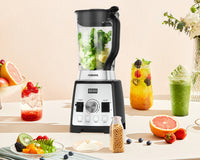Among the important pantheon of kitchen appliances today, blenders, food processors, stand mixers, hold a top-notch place. All these appliances serve different purposes from chopping, grinding, blending, mixing, and more. The most commonly used are food blenders and food processors, however, did you know they are quite different even though often they seem the same. A quality blender like Acekool Blender BH1 ensures hassle-free blending and mixing while an efficient food processor will provide enough assistance in tasks like chopping, grinding, and more.

Before we shift our focus to highlighting the difference between a food processor and a blender, let’s shed some light on both these appliances and their functionalities.
What is the Difference Between a Blender and a Food Processor?
Differences between both the appliances are quite prominent on many levels, be it the mechanism or tasks assigned. However, to put it in simple terms, we can say the primary function of a food processor is to perform food preparation tasks while a blender, typically, pulverizes or rather combines dry and liquid ingredients.
So, if you need help with manual cooking chores, then you must go for a food processor. Plus, the food processor blades are much better than the blades of a blender. That means, the S-shaped blades of a food processor rotates at a lesser speed and hence offer much better control than a blender. Also, these blades are plain-edged, which delivers clean cuts. Hence, such blades are mostly used for chopping and grinding. Some blade attachments of the food processor are serrated, which works on frozen food and makes puree too. On that note, it becomes clear that the pre-cooking work can be done with much ease if you own a food processor.

On the other hand, the blades of a blender are mostly two types- X-shaped and Wing Blades. Generally, these blades are fitted at the bottom side of the blender, which is immersed in the blending beaker. The X-shaped blades are usually six or four but the six blades model is often considered more efficient in blending. Besides, the Wing blades have blunt edges, which tend to turn up or down. Hence, it is mainly used for crushing hard ingredients like frozen berries or ice. For this reason, blenders are mostly used for making smoothies or frozen drinks/cocktails.
Apart from this, the blenders, especially immersion blenders, don’t have any specific jars for blending, as you just need to dip it in any glass or narrow opening container when using it. But it’s not the case with a food processor, as it comes with multiple bowls, each specific to the type of work it does. So, you get a different bowl for chopping vegetables and a separate one for kneading dough. However, you can go for the Acekool Blender BH1, as it comes with a blending beaker and a chopping bowl, and it’s budget-friendly.

In Conclusion
Now that you know, what’s the difference between a food blender and a processor, you can decide on which appliance to resort to, depending on your need.












